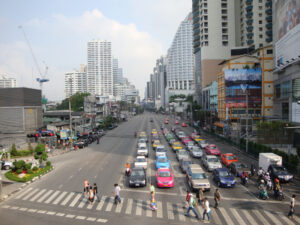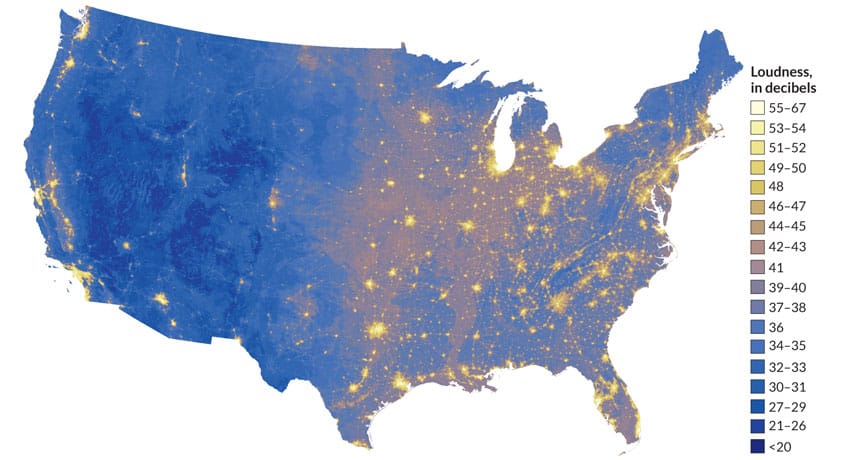The rumble of an airplane overhead. The whistle of a passing train. Garbage trucks backing up. Construction machinery and jackhammering. All of these sounds fall into the background of your attention when you’re used to them, but how might this noise be affecting you over time?
Ecological Impacts of Noise Pollution
Well, if you’re a songbird that communicates in lower pitches for mating, be ready to be drowned out by street noise at a similar frequency as your song. If you’re a bat who uses echolocation to find your dinner, you may take about twice as long to find your food. Imagine yourself as a zooplankton floating your way through the Atlantic Ocean… let’s hope you aren’t flat out killed by a sudden burst of noise from drilling equipment.
The impacts of human-created noise on the environment are being explored by ecologists all over the world—but did you know that humans are also affected by noise pollution?
Effects of Noise Pollution on Human Health
Studies have found that that exposure to excess noise, also termed “noise pollution,” is a threat to human health that has been overlooked.
The World Health Organization (WHO) recommends noise less than 30 human-adjusted decibels (dBA) for high quality sleep. City traffic is about 85 dBA, which clearly isn’t ideal for sleeping, but also falls within the range of noise exposure that results in long-term hearing loss.

According to some sources, those living in urban environments are continuously exposed to about 60 dBA of background noise. Major contributors of noise pollution are:
- automobile traffic
- factory production
- airplane traffic
- construction sites
What makes the most common forms of noise pollution particularly frustrating to residents within earshot are the intermittent and unpredictable nature of sounds such as train whistles and plane engines. Studies indicate that random noise can be more frustrating than low-level persistent noise.
Noise can also be an indicator of other pollution problems. All of the above contributors of noise pollution are also notable activities associated with particulate air pollution, which is a well-established risk to public health.
And people continuously exposed to high levels of noise (80-90 dBA) may experience negative health impacts. The Environmental Protection Agency note noise annoyance, sleep disturbance, hearing impairment, cardiovascular disease, and cognitive performance interference as just a few of the notable effects that excess noise can have.
Environmental Justice Concerns Surrounding Noise Pollution
Like many environmental issues that have ecological consequences, noise pollution disproportionately affects groups of impoverished and minority populations.
Research shows that the distribution of the effects of noise exposure is not universal—some groups are at higher risk. For instance, those with chronic illness and the elderly are more sensitive to disturbance. Children are more likely to experience cognitive performance interference, for instance in a school setting, as a result to airplane noise exposure.

It’s important to consider the demographics and location of those most impacted. It can be reasonably inferred that urban areas are going to be noisier than rural or suburban ones through simple evaluation of population density, and there are studies that confirm this assumption. Even within cities there is inequity in noise pollution exposure in lower income and higher minority populated areas.
A team of researchers in 2017 found that within cities in the United States, neighborhoods with higher proportions of nonwhite and lower socioeconomic experience higher levels of noise. This issue is not only a domestic one; there have been studies completed globally that show similar patterns of environmental injustice.
What action is being taken to reduce noise pollution?
The burden of noise control in the United States is placed upon individual states and local governments. The EPA’s Noise Control Act of 1972 attempted to tackle the issue of excess noise, but its funding has since been rescinded.
Many states have local noise codes that limit the amount of noise that’s legal at certain times of the day. In New York, there are restrictions on the volume of commercial music in, for instance, grocery stores. Additionally, there is guidance and resources for construction sites.
Another strategy for reducing noise is increasing plant life to dampen noise. Studies show that higher amounts of green infrastructure, including garden roofs and vertical gardens can reduce noise pollution.
So what can you do about it?
- Educate yourself and others
- Videos by Tech Insider and Vox give quick summaries of the issue to share with friends and family.
- The EPA has great downloadable worksheets and lessons for parents and teachers to teach kids about noise pollution.
- Advocate for change
- The Sierra Club is pushing for government leaders to address noise pollution as a serious issue. Read more here to find out what legislation they are advocating for and how you can get involved.
- Consider small ways you can reduce your exposure to noise pollution in your everyday life
- Some of my favorite tips are to wear earplugs to sleep and keeping the volume of your electronics low because they’re so easy.
- With a little more time and effort, you can take it a step further by planting trees in your yard or installing insulation to dampen sound.
Like most environmental issues, there are no overnight solutions. But, hopefully, there are ways that each of us can take small steps toward making big change.
